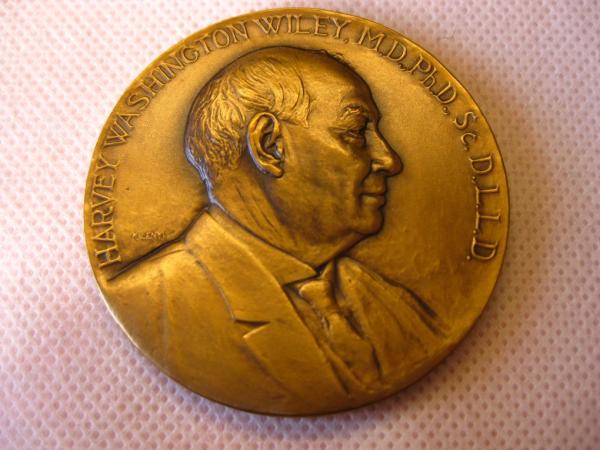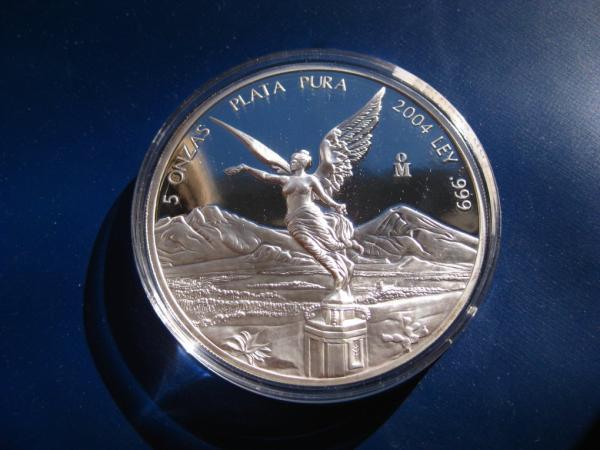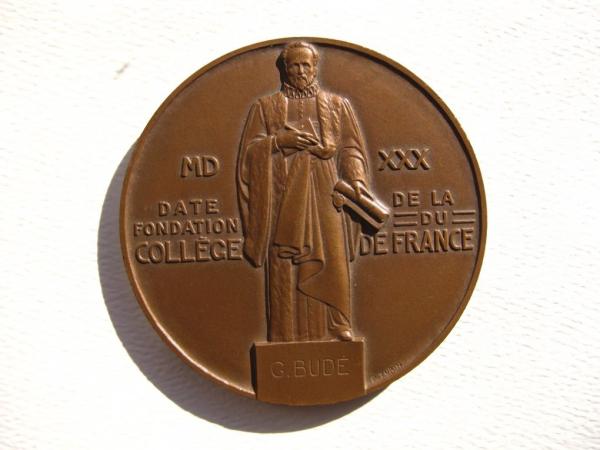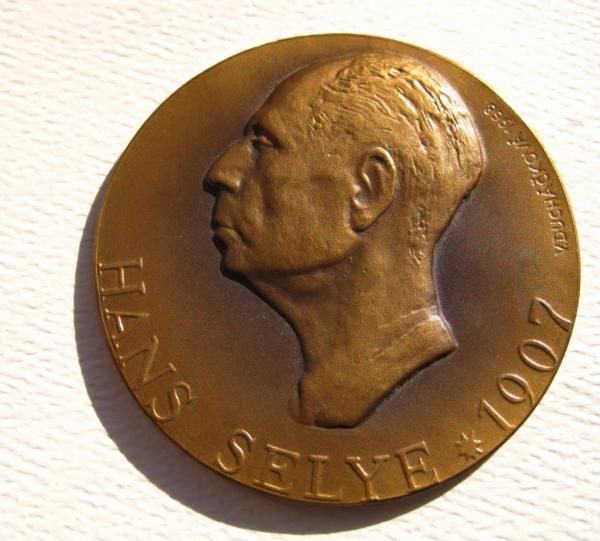Medallions and Medicine
Medallions and coins are both beautiful artwork and symbols of what achievements and people we value. These are some of the beautiful medallions and coins in our collection—and the stories that go with them.
The first medallion shown here at left is a little mysterious. What we do know is that it was struck by the Italian company Lorioli Fratelli, which also created works for the Vatican.


The front shows a sun with a banner holding three Zodiac signs: a lion (Leo), a judge (Virgo), and a balance (Libra). The Latin “certissima signa sequentur” is a quote from Virgil’s First Georgic about these three trusty signs that travel with the sun. The reverse at right shows the coat-of-arms of Mantova (Mantua), Italy, which includes a little bust of Virgil, who was born near Mantova. In 1982, this medallion was given to NIH National Institute of Mental Health scientist Julius Axelrod, who won the 1970 Nobel Prize in Physiology or Medicine for his work on brain chemistry.
Mystery in the above medallion: Why did the city of Mantova give Axelrod the medal? We can find no mention of a connection between the city and the scientist in his papers. If you know more of the story, please let us know too!


Cyrus E. Dallin (1861-1944) is an important American sculptor best known for the iconic statue of Paul Revere in Boston. Born in Utah, Dallin studied sculpture and settled in Boston. He created the Theodore William Richards medal for the Northeastern Section of the American Chemical Society, which awards it every two years. Richards (1868-1928) was the first American to win a Nobel Prize in Chemistry (1914) for determining the atomic weights of over 55 chemical elements.
The particular Richards medal shown above was awarded to Claude Hudson, who clarified the relationship between the chemical structure of sugars and the rotation of polarized light. Hudson (1881-1952) worked at the U.S. Department of Agriculture and the National Bureau of Standards before becoming the last Professor of Chemistry at the Hygienic Laboratory (now the National Institutes of Health). See more of Dallin’s art at the Cyrus E. Dallin Art Museum.


This medallion was originally commissioned in 1924 to celebrate Harvey Wiley’s 80th birthday by the Association of Official Agricultural Chemists. Wiley was involved in getting the Pure Food and Drug Act of 1906 passed, and served as the first commissioner of the Food and Drug Administration. He then became the editor of Good Housekeeping magazine. The FDA now uses the medal as a special award. This particular medal was struck in 1996, and given to Ruth Kirschstein in 1997, for her service on the Science Board Subcommittee on FDA Research, which reviewed the FDA's intramural science program. Artist Julio Kilenyi (1885-1959) was born in Hungary, moved to Argentina, and immigrated to New York; he created over 50 works for the Medallic Art Co.


This beautiful coin symbolizes an agreement between agencies in two countries: the Mexico National Council on Science and Technology and the U.S. National Institutes of Health. The coin was given to NIH director Elias Zerhouni in 2006 to commemorate a joint program training U.S. and Mexican students in clinical research; allowing mid-career scientists to work in Mexico or in the U.S. short-term; bringing Mexican postdocs to NIH and then returning home; and identifying areas for joint research. The Silver Mexican Libertad coin depicts the angel of Independence soaring over the volcanos Popocatepetl and Iztaccihautl. Historical coats of arms surround the Mexican coat of arms on the reverse side.


I have not seen other images of this medallion of Nikola Tesla, which features four raised sections around a relief of his face. Three sections refer to important dates and places: Tesla’s birth in Smiljan, Croatia, 1856; his death in New York City, 1943; and the Central European Oncology Congress in Zagreb, 2006. That’s where this medallion was given to Elias Zerhouni, then director of the National Institutes of Health. Tesla, an inventor who gave his name to NMR and MRI machines, is known for his alternating current (AC) induction motor and his vision of a future of wireless communication. The structure on the medallion’s reverse is Tesla’s Wardenclyffe Tower, a wireless communication and power transmitter that Tesla was unable to finish. Unfortunately, there is no artist information for this medallion; if you have an idea, please let us know.

A medallion can be a token of remembrance of the event for which it is created and for future events, as is this one celebrating the 100th anniversary of the Charles Nicolle Hospital in Tunis, Tunisia. Nicolle (1866-1936) was born and trained in France, but became director of the Pasteur Institute in Tunis in 1903. It was there that he showed how lice transmit typhus, work for which he won the 1928 Nobel Prize in Medicine. The hospital bearing his name was established in 1897; its name was changed to his in 1946. This medallion also commemorates the visit of Elias Zerhouni, director of the National Institutes of Health, in 2006. The NIH delegation visited North Africa to strengthen collaborations, including regional conferences on newborn screening and HIV/AIDS, training for North African librarians, and support for women scientists to attend a major regional workshop on women in science. "The staff at the U.S. embassies in all three countries [Tunisia, Morocco, and Algeria] remarked that they had rarely witnessed such a well-received U.S. delegation," noted Judy Levin, program officer for the Middle East and North Africa at the Fogarty International Center.


On this medallion, Guillaume Bude (1467-1540) is depicted as the man of learning that he was, holding a book, pen, and scroll. Among his many accomplishments, his suggestion for the creation of the Collège de France, which holds free classes open to everyone, is celebrated with this medallion. Pierre Turin (1891-1968) was the Art Deco artist who created this medallion, along with different franc coins. The medallion was given to National Institute of Mental Health scientist Julius Axelrod, at a conference held in Paris on November 19, 1970. Axelrod had just won the Nobel Prize in Physiology or Medicine for his work on brain chemistry.


Thomas W. Salmon’s friends and colleagues commissioned Charles Keck (1875-1951) to create this bas relief portrait of Salmon (1876-1927), who was a Professor of Psychiatry at Columbia University. The original inscription read: “Beloved Physician, Teacher, Mental Hygiene Leader, Whose Vision Guided the State and the University in Placing Here This Psychiatric Institute and Hospital.” Keck was a well-known sculptor who also created the seal on the Virginia flag. Salmon’s friends also established an annual lecture in psychiatry in his honor, which Julius Axelrod delivered in 1972. If you know the symbolism of the sailing ship, please let us know.


This is one of my favorites in our medallion collection because of the portrait of Hans Selye. Growing up in Slovakia, where this medal was struck, Selye (1907-1982) received his Ph.D. in Prague but ended up in Montreal, although he never forgot his native Hungarian. He wrote over 1500 research papers, most on the biological aspects of stress. This medallion was created for the Masaryk University Faculty of Medicine in Brno, Czech Republic by Věra Ducháčková (1909-1994), a sculptor of the socialist realist style. This medal, like many others in our collection, was given to Julius Axelrod.
Related Blog Posts
This page was last updated on Wednesday, July 5, 2023
